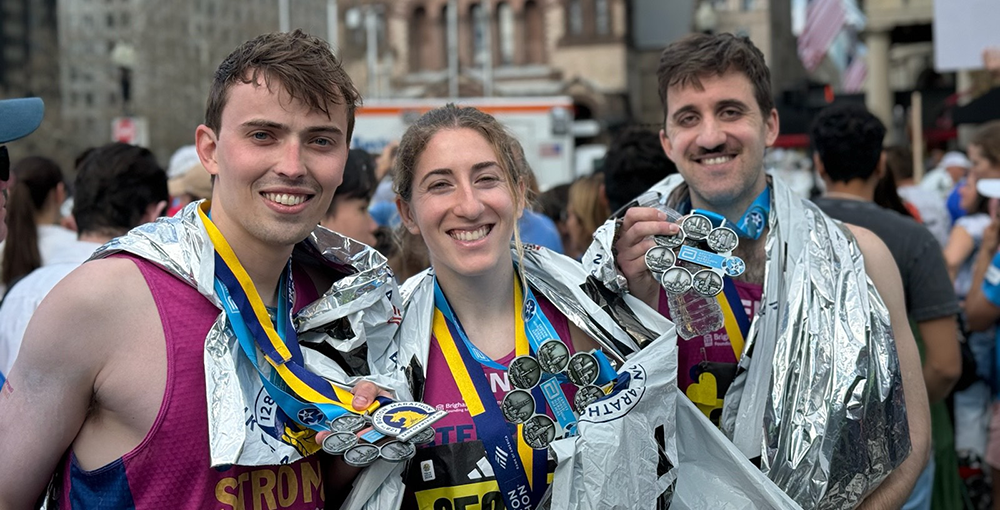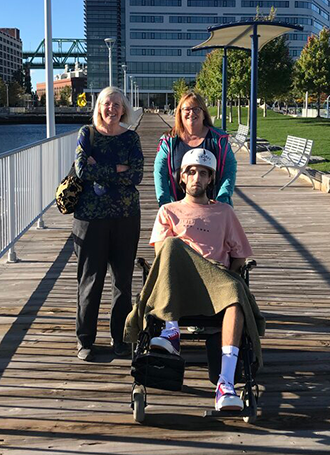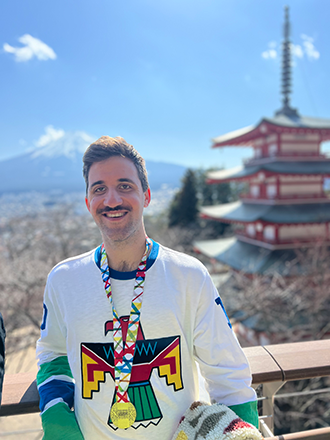
When Jeff Kaplan puts his mind to something, he does it. The 32-year-old is an electronic music producer, manages his own e-commerce business, volunteers with Athletes Unlimited and the Special Olympics as well as at a rehab center, and is a marathon runner. That’s impressive enough — and even more so considering that a few years ago Jeff suffered a traumatic brain injury that left him unable to walk, let alone run. After a series of surgeries, culminating in one with Dr. Philip E. Stieg, Jeff is back in the race.
“Before the accident, I’d never even considered myself a runner,” says Jeff, who lives in Newton, Massachusetts. “I had run the Bay State Marathon in 2016, but mostly running was just something I’d occasionally do with friends on Sundays. I have no idea why I even signed up for the 2018 New York City Marathon, but I was out training for it one day when I was hit by a car. I was rushed to the emergency room, and the doctor told my family I might not make it — and if I did, I might live in a vegetative state for the rest of my life.”
Jeff spent two weeks in a coma, and when he woke up he says he was “in a mental state between an infant and a teenager.” He didn’t know what had happened to him, or about the craniectomy he’d undergone (surgeons had removed a section of his skull to relieve pressure on his brain). He couldn’t speak or walk, and he couldn’t remember much about anything.

Jeff's mother and aunt taking Jeff on a break from all the therapies he was undergoing in rehab. All photos courtesy Jeffrey Kaplan
“Jeff’s original brain injury was quite severe,” says Dr. Philip Stieg, Chair of Neurological Surgery at NewYork-Presbyterian/Weill Cornell Medical Center. “The car hit him with tremendous force, and he hit the windshield and then the curb. That caused the brain to move significantly within his skull, damaging it enough to cause memory loss and a loss of feeling in the left side of his body. Injuries like his are often the start of a very long journey, as Jeff and his family have learned.”
That journey started with more than a month in the hospital, followed by a transfer to a rehabilitation center for intensive therapy. During his six-week stay in rehab he went back to the hospital for a cranioplasty, in which the missing piece of his skull was replaced by a 3-D printed prosthetic. Finally, Jeff was able to move to outpatient therapy, but he describes it as a very low point.
“I saw my old personal trainer, Hank, who had worked on basketball with me during my teenage years,” he says. “Now I was in an adult diaper, and I couldn’t walk longer than eight seconds. Hank stressed to me that there was a lot of work to be done, that this was not a ‘one and done’ thing. I couldn’t rush my way back to whatever ‘Jeff 1.0’ was like. Hank told me that ‘this is Jeff 2.0,’ and that I needed to get used to that.”
Jeff decided to re-evaluate his life. “Before my accident, I was self-absorbed,” he reflects now. “I took shortcuts in my relationships with work, friends, and family. I realized after surviving a TBI that there would be no more shortcuts. For Jeff 2.0 I was focusing on my health, both mentally and physically.”
"Even when one of the worst things in life happens, you can find the inner strength and outside help and push through it.”
As part of that focus, Jeff decided he would run the New York City Marathon after all, and a year after the accident he was back training.

Jeff Kaplan ran the 2019 NYC Marathon a year after his accident.
“After I miraculously ran the 2019 New York City Marathon, I shared my story with brain injury survivors and other runners,” he says. “It’s not just about running, but about showing people that even when one of the worst things in life happens, you can find the inner strength and outside help (especially with support of friends and family), and push through it.”
Jeff’s journey was not over, though. Three years after the accident his prosthetic skull section became infected and had to be removed. After the surgery he went back to physical rehab, taking antibiotics to fight the infection and wearing a helmet to protect the part of his skull where that section had been. After he completed the course of antibiotics, surgeons inserted a replacement skull prosthetic — which became infected a week later.
After another surgery to remove the newly infected skull portion, Jeff learned that a substitute dura (the thick membrane that protects the brain and spinal cord) had been implanted in the first surgery to replace the original dura which, along with the prosthetic, was unusable. That substitute dura may also have become infected, so the decision was made to remove it. “The surgeon wanted to remove everything that was not me,” says Jeff, “to try and prevent any further infections.” But removal of that dura led to seizures, along with significant loss of the use of Jeff’s left hand. “I had to be on antibiotics for almost a year, with another helmet, and no running for 201 days. The setback was super depressing for me.”
"After talking to Dr. Stieg and hearing him say yes, he would like to do this, everything in my life started coming back together — my skull included.”
Thankful for the initial surgeries that had saved his life, but increasingly concerned about the recurring infections, Jeff and his dad, Rich, decided to search for an alternative surgical procedure that might solve these problems, hopefully once and for all. “I had to find a surgeon with an approach to get this right or I’d never run again,” says Jeff. “My dad was all in — he researched medical articles, contacted experts all over the world, and investigated cutting-edge treatments. Our search narrowed down to a handful of surgeons in New York, France, Pennsylvania, and Baltimore, ultimately deciding to go with Dr. Stieg. We wanted to see Dr. Stieg for his opinion. We didn’t think he’d agree to take on my complicated case, but after talking to him and hearing him say yes, he would like to do this, everything in my life started coming back together — my skull included.”
Rich agrees. “Dr. Stieg discussed Jeff’s case with us as though it were a routine procedure for him. From my research, I knew that Dr. Stieg had a tremendous amount of experience, far more than some of the others we talked to, and he was an acknowledged expert. We even listened to some of his podcasts. From the very beginning, Dr. Stieg’s staff was amazing, especially his nurse practitioner, Elaine, who was always available and responsive.”
“We know there are no routine cases for patients,” says Dr. Stieg, “but the sheer volume of people we treat here gives us a greater understanding of cases and outcomes as well as the foresight to outline a backup plan. We are also a multidisciplinary practice, and for this surgery we collaborated with Dr. David Otterburn in plastic surgery to bring the best skills to the table.”
"Recovery is a full-time job early on, and it feels like one. It’s really a never-ending marathon."
In October 2022, after a more defined and longer presurgical course of antibiotics, the team came together in the operating room to perform another cranioplasty — this time including repairs to the dural substitute that had been inserted during the previous surgery. Dr. Stieg placed a new dural graft, and Dr. Otterburn took care of the new prosthetic skull. Jeff and Rich both marveled at the experience.
“The approach that Dr. Stieg and his team brought to the table was different from what we had experienced in Jeff’s earlier surgeries — and exactly what Jeff needed,” says Rich. “Jeff’s prior surgeries did not have a plastic surgeon involved, nor was Jeff prescribed a full course of six months of antibiotics until after the second infection. Jeff’s surgical recovery at NewYork-Presbyterian was also different. He was placed in a private corner post-surgery room, then he was moved to a private room, where he received lots of attention. My wife and I were fortunate to be able to stay in NewYork-Presbyterian’s Guest Facility, the Helmsley Tower. Jeff was out of the hospital in days, compared to weeks at our local hospital when Jeff had all of his complications. Our NewYork-Presbyterian experience truly was far different from what we had experienced before.”
“I was allowed to start running again three weeks after my surgery,” says Jeff. “They did such a good job that Dr. Otterburn couldn’t even find the scar where he’d worked on me; his PA had to find it for him!”

Jeff Kaplan after finishing the Tokyo Marathon
Jeff has now raced his way to Jeff 2.0, having completed all six of the Abbott World Marathons (New York, Chicago, London, Tokyo, Berlin and Boston). Today he is working towards his next big milestone: capturing his experience into a book, which he’s calling Jeff 2.0.
“I found solace in understanding that it wasn’t something a band-aid could fix,” Jeff says. “I had my family and friends, and together we put as much effort as possible into my recovery. Recovery is a full-time job early on, and it feels like one. It’s really a never-ending marathon. But the more work I put in, the easier things get. And there are setbacks, always. To anyone who’s going through what I did, don’t be shy to tell others what’s going on, whether they’re family, friends, or doctors. They’re here to help you. Always advocate for yourself and don’t give up. My first surgeon saved my life, but Dr. Stieg and his staff put me back in the game.”